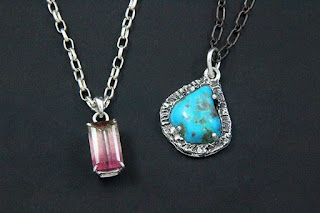 On the second day of the wax for stone setting class, I took a completely different approach - and used a stone at the opposite end of the spectrum from the tourmaline - a free form turquoise nugget.
On the second day of the wax for stone setting class, I took a completely different approach - and used a stone at the opposite end of the spectrum from the tourmaline - a free form turquoise nugget.After a couple of failed attempts to create a basket with wire, Steve suggested building a setting with wax sheet as the base, and using a heavier wire to create a bezel and prongs to fit the stone's uneven shape.

That's exactly what I did, and it worked really well. Then I used the wax pen to create texture in the bezel, as well as securing it to the wax sheet by melting them together.
I also took some smaller pieces of sheet and wire and formed a couple of bails. I wasn't sure quite what I wanted in terms of a bail for this piece, and as it turned out, I didn't get one of them quite right - but again I learned something in the process.

With all my wax work done, it was time to sprue the pieces and put them in a flask for casting. Spruing is the process of connecting each piece to a wax stem (the sprue) that will create a pathway for the molten metal to flow into the void in the casting flask that is left when the wax burns away. This is why the process is called lost wax - when the flask is fired in a kiln, the wax is lost, and a one-time mold is left for the metal.

The flasks containing the wax and investment (plaster of paris material that creates the mold) were fired overnight on Saturday, and the metal casting was done Sunday morning. I arrived at the studio to find that my wax had all cast successfully, and set about cutting the excess silver away and finishing each piece.

I said earlier that I had made a mistake with one of the bails - and you can see it here - the larger bail should have been cast with the ends open, and probably with a small pin on one side - so that it could be put through the jump ring on the pendant.
 I tried sawing it open and soldering a pin in place, but that didn't work very well - so I chalked that up to a good learning experience, and used the smaller bail (which also had to be sawed open) on the turquoise pendant.
I tried sawing it open and soldering a pin in place, but that didn't work very well - so I chalked that up to a good learning experience, and used the smaller bail (which also had to be sawed open) on the turquoise pendant.To clean up and prepare the settings for the stones, we used both hand and power tools, with increasingly finer grades of grit, to create a bright, clean finish on the silver.
As with fabrication, setting the stone is the very last step - and needs to be done with care and patience. Steve worked his way around the room to every bench, helping each of us to ensure that all our hard work was not lost to a slip of the hand or a tool.
Once again - I left Creative Side with knowledge spilling out of my ears, and two beautiful pendants to add to my growing collection.
Until next time.

No comments:
Post a Comment